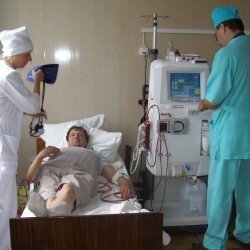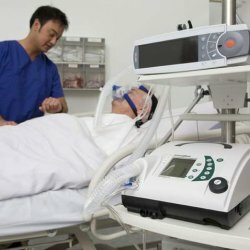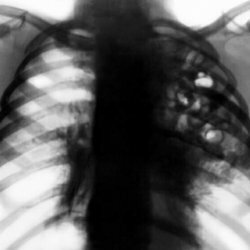Hepatopulmonary syndrome
 Pathological changes in the circulatory system can lead not only to portal hypertension, but also to the malfunction of all organs, not excluding the lungs. If, in addition to portal hypertension, the vessels of the small circle of blood circulation begin to function incorrectly - there is a risk of hepatopulmonary syndrome. This is a rather serious disease, which can lead to even a fatal outcome.
Pathological changes in the circulatory system can lead not only to portal hypertension, but also to the malfunction of all organs, not excluding the lungs. If, in addition to portal hypertension, the vessels of the small circle of blood circulation begin to function incorrectly - there is a risk of hepatopulmonary syndrome. This is a rather serious disease, which can lead to even a fatal outcome.
Hepatopulmonary syndrome is the dysfunction of the lungs, combined with chronic liver disease. Most often this syndrome occurs in patients with cirrhosis of the liver. The disease is characterized by a decrease in the level of oxygen in the arteries, which is caused by a violation of perfusion-ventilation relations and dilatation( expansion) of small pulmonary vessels.
According to various studies, the prevalence of hepatopulmonary syndrome reaches 5-17% among patients with cirrhosis and 18% among those who need liver transplantation. PGR diagnosis is based on the presence of 3 factors:
- Chronic liver disease is portal hypertension or arterial hypoxemia
- presence
- pulmonary vascular dilatation
Development Mechanism To date, the mechanism of occurrence and development of this syndrome are not fully known. However, the association between the presence of portal hypertension and the dilatation of the lung capillaries does not cause controversy. Portal hypertension provokes the translocation of certain bacteria and toxins, which leads to increased production of NO in the lungs. The pathological effect of this substance has already been proven by many studies of scientists and physicians. The consequence of the expansion of the capillary vessels is the shunting of blood in the direction from right to left, and also the balance between ventilation of the lungs and their perfusion is disturbed. The result is a small oxygenation of the vessels and respiratory failure.
Modern scientists believe that the basis of the GPA are 3 mechanisms:
- shunting of blood in the veins and arteries
- mismatch between ventilation and perfusion lung
- Violation of oxygen diffusion
Symptoms of SBS
One of the most common SBS symptoms - shortness of breath. It can manifest not only during physical exertion, but also when a person changes the position of the body in space - from horizontal to vertical position. Such shortness of breath is called platypnea. This is due to the fact that with this syndrome the vessels have the ability to expand more in the lower part of the lung, therefore in the standing position blood pressure decreases. Over time, shortness of breath more often overtakes the patient and worries him almost constantly. Also, with FBS, telangiectasias, thickening of the terminal phalanges of the fingers, cyanosis of the nail beds and lips can be observed. In rare cases, intracranial hemorrhages develop, polycythemia develops.
Diagnostics of GPS
The European respiratory society has created a classification, according to which the degree of severity of the GPS is diagnosed depending on the degree of hypoxia. It is determined by the level of partial pressure of oxygen in the arteries.
- Light( O2 pressure more than 80 mmHg)
- Moderate( O2 pressure more than 60 mmHg)
- Weight( O2 pressure less than 60 mmHg)
- Extremely heavy( O2 pressure less than 50 mmHg)
first stage diagnosis isPulsometry - this procedure allows you to analyze the saturation of blood with oxygen. If in the vertical position the level of saturation is less than 92%, and in the lying position is reduced by 4% or more, doctors perform the procedure for determining the gas composition of blood in 2 positions - vertical and horizontal.
If it is found that the partial pressure of oxygen is lowered, and in a standing position increases sharply, it is recommended to conduct noninvasive contrast-ehokadiografiyu or scintigraphy.
The procedure of contrast echocardiography is that a patient in the peripheral vein is administered a special contrast drug - gelofundol. This drug can not normally pass through the pulmonary capillaries, but in the presence of shunts in the pulmonary vessels, the substance can reach the left heart. With the help of echocardiography, the presence of contrast medium in the heart is determined and the disease is diagnosed.
Scintigraphy allows to determine whether there is dilatation of vessels and whether shunting occurs. The procedure is similar to the previous one;Special preparations in a healthy person should be retained in the vessels of the lungs, in the presence of pathologies of the vessels, the introduced substance is found in the spleen, in the brain and other organs.
Angiography of vessels is used to diagnose the topography of dilated vessels. This procedure allows us to identify not only places of dilatation of the lung vessels, but also the type of FBS itself. Expansion of precapillary vessels is observed in type A, the presence of vascular shunts indicates a type of HA B.
Treatment of
FBS can seriously complicate the life of the patient, with the syndrome, the prognosis is not at all comforting. According to large studies, survival in these patients is reduced from 40.8 months( in patients with cirrhosis of the liver without this syndrome) to 10.5 months( patients with FBS).
There is no universal treatment regimen for FBS.This syndrome is still being investigated, but so far no scientists have found drugs that can effectively prevent dilatation of the lung vessels. In the form of experiment, scientists injected various drugs - methylene blue, okreotides, prostaglandins, beta-blockers and nitrates, but they had no influence on the control of the GPS, or the effect was too small. A positive result is given by a procedure such as selective embolization of shunts in pulmonary vessels. Sometimes the use of transureular portosystemic shunting helps in the treatment of portal hypertension. This procedure is most often performed as an intermediate stage before a liver transplant.
In severe hypoxemia, doctors carry out constant oxygen therapy, which helps to saturate blood with oxygen.
Not so long ago it became known that garlic can help patients with FBS and some doctors prescribe to their patients capsules with garlic as an additional therapy. After 6 months of treatment with garlic in humans, there was an increase in oxygenation of the blood. Also, aspirin therapy provides positive results, but so far these methods have not been fully investigated, which makes it impossible to use them universally.
The radical methods of treatment of FBS include liver transplantation. In many cases, after a transplant, the condition of the patients improves, perhaps even complete elimination of the syndrome.
The final part of
Hepatopulmonary syndrome is a rather dangerous disease that can occur in a person with a neglected liver condition. The prognosis for a sick person is unfavorable, without any treatment the probability of a lethal outcome is quite high. Unfortunately, conservative methods of treatment are not effective. Perhaps in the future, scientists will find drugs that will be able to cure this disease, and now, in most cases, only a liver transplant can help such a patient.



